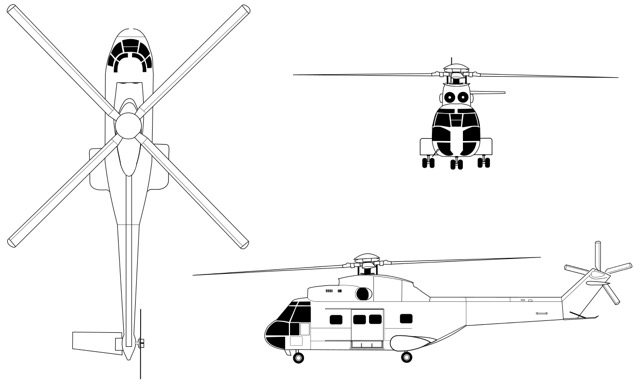SA330 Puma
Summary
| Category | Military Helicopters |
| Origin country | 🇫🇷 France |
| Manufacturer | Aérospatiale |
| First flight | 15 April 1965 |
| Year introduced | 1968 |
| Number produced | 697 units |
| Average unit price | $2 million |
Description
The SA 330 Puma was initially developed by Sud Aviation in response to a French Army requirement for a medium-sized all-weather helicopter capable of carrying up to 20 soldiers or performing cargo transport duties. Development commenced in 1963 with French government backing. The first of two Puma prototypes achieved its maiden flight on 15 April 1965, followed by six pre-production models, with the last flying on 30 July 1968. The first production SA 330 Puma flew in September 1968, and deliveries to the French Army began in early 1969. In 1967, the Royal Air Force selected the Puma, leading to a joint manufacturing agreement between Aérospatiale and Westland Helicopters, with Westland manufacturing components and assembling Pumas for the RAF. The SA 330 proved successful on the export market. Romania produced the Puma under license as the IAR 330, while South Africa developed the Atlas Oryx based on the Puma's design. In 1974, Aérospatiale began developing improved variants, resulting in the AS332 Super Puma. Production of the SA 330 Puma by Aérospatiale ceased in 1987, with 697 units sold; however, production in Romania continued.
The Aérospatiale SA 330 Puma is a twin-engine helicopter configured primarily for personnel transport and logistic support. It accommodates up to 16 soldiers on foldable seats or six litters with four attendants for casualty evacuation. It is also capable of cargo transport, carrying up to 2500 kg either internally or via an external cargo hook. Powered by two roof-mounted Turbomeca Turmo turboshaft engines driving a four-blade main rotor, the transmission incorporates a single-part rotor shaft and anti-vibration measures. The helicopter includes an automatic blade inspection system and redundant hydraulic systems for flight controls and other functions. Designed for high speed, maneuverability, and performance in challenging conditions, the engines have reserve power for single-engine flight at maximum weight. The cockpit features dual controls and a SFIM-Newmark autopilot. The Puma is air-transportable by tactical airlifters with detachable components and designed for ease of maintenance, capable of operating at night and in various climates. Modernized variants feature added GPS navigation, self-defense measures, digital systems, and glass cockpits.
The Aérospatiale SA 330 Puma could be fitted with various armaments, though it was primarily designed for transport and utility roles. Some versions featured coaxial 7.62 mm machine guns or side-firing 20 mm cannons for self-defense or offensive capabilities. The Lebanese Air Force converted an IAR 330 SM into a helicopter gunship by mounting a single ADEN Mk 4/5 30mm revolver cannon on a modified pod, along with a pair of SNEB 68mm rocket launchers on each side; however, this configuration was not accepted for active service. The Puma's versatility allowed for a range of other armaments to be fitted by different operators.
The Aérospatiale SA 330 Puma has been deployed in various theaters and conflicts. During the Falklands War, Argentine Pumas were deployed. The type played a role in French service as a VIP transport. During the First Gulf War, French Pumas were retrofitted with GPS for combat search-and-rescue. As part of the NATO-led intervention in the Yugoslav Wars, French Pumas operated in the region providing humanitarian aid and extracting special forces from hostile territory. Portugal employed the Pumas in combat during the Portuguese Colonial War. South African Pumas were deployed during the Border War. The Royal Air Force (RAF) utilized Pumas in conflicts such as the Falklands War and Iraq War, and in regions such as Venezuela, Yugoslavia, and Zaire. The Puma's operational strengths included its troop-carrying capacity, maneuverability, and performance in hot-and-high conditions; however, shortcomings in equipment such as night vision goggles have been noted.
Main Variants:
-
SA 330A: These were the prototypes of the Puma.
-
SA 330B: This was the initial production version designed for the French Army Light Aviation, powered by Turbomeca Turmo IIIC4 engines.
-
SA 330C: This was the initial export production version, featuring more powerful Turbomeca Turmo IVB engines.
-
SA 330E: This variant was produced by Westland Helicopters for the Royal Air Force (RAF) under the designation Puma HC Mk 1.
-
SA 330H: This was an upgraded French Army and export version equipped with Turbomeca Turmo IVC engines and composite main rotor blades, designated SA 330Ba by the French Air and Space Force.
Technical specifications
| Version: SA330H Puma | |
|---|---|
| Crew | 1 pilot + 1 copilot + 1 member |
| Operational range | 580 km (360 mi) |
| Maximum speed | 257 km/h (160 mph) |
| Wingspan | 15 m (49.2 ft) |
| Height | 5.1 m (16.9 ft) |
| Length | 18.2 m (59.5 ft) |
| Service ceiling | 4,800 m (15,748 ft) |
| Empty weight | 3,536 kg (7,796 lbs) |
| Max. takeoff weight | 7,000 kg (15,432 lbs) |
| Climb rate | 7.1 m/s (23.3 ft/s) |
| Powerplant | 2 x Turbomeca Turmo IVC turboshafts, 1,175 kW each delivering 2350 kW each |
Current operating countries
All operators
